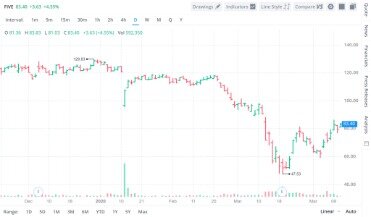
The market is thought of as a leading indicator and generally leads the economy by 6 to 9 months. To keep pace with the market, it makes sense to look directly at the price movements. Even though the market is prone to sudden knee-jerk reactions, hints usually develop before significant moves.
Of course, a smart trader will consider lots of other factors, like a company’s financial conditions. But trend analysis is another valuable asset to add to your toolkit. An uptrend (bullish trend) is a price movement in an upward direction, where each subsequent maximum is higher than the previous one, and each subsequent low is higher than https://trading-market.org/ the previous ones. With a selection of stock charts from each industry, a selection of 3-4 of the most promising stocks in each group can be made. How many stocks or industry groups make the final cut will depend on the strictness of the criteria set forth. Under this scenario, we would be left with 9-12 stocks from which to choose.
Different statistical measures can yield different results, and it’s important to be aware of the limitations and assumptions of the statistical methods being used. A trend is a general direction the market is taking during a specified period of time. We observed oscillatory and symmetric patterns across four different clustering methods. These patterns were not good indicators of potential profit or loss. The head and shoulders chart pattern and the triangle chart pattern are two of the most common patterns for forex traders. They occur more regularly than other patterns and provide a simple base to direct further analysis and decision-making.
How do you analyze stock trends?
If you study prices over a long period of time, you will be able to see all three types of trends on the same chart. Watch the slope – The slope of a trend indicates how much the price should move each day. Steep lines, moving either upward or downward, indicate a certain trend.
You’ll likely find that some indicators work very well for you in forecasting price movement for some stocks but not for others. Some traders use white and black candlestick bodies (this is the default color format, and therefore the one most commonly used); other traders may choose to use green and red, or blue and yellow. Whatever colors are chosen, they provide an easy way to determine at a glance whether price closed higher or lower at the end of a given time period. Technical analysis using a candlestick charts is often easier than using a standard bar chart, as the analyst receives more visual cues and patterns. Many fundamental traders use fundamental analysis to determine whether to buy into a market, but having made that decision, then use technical analysis to pinpoint good, low-risk buy entry price levels.
Searching for Patterns in Daily Stock Data: First Steps Towards Data-Driven Technical Analysis
Stock charts are freely available on websites such as Google Finance and Yahoo Finance, and stock brokerages always make stock charts available for their clients. In short, you shouldn’t have any trouble finding stock charts to examine. For example, assume that the price of stock “A” has climbed steadily from $10 to $40. Many investors will look for a good entry level to buy shares during such a price retracement.
If a stock has already advanced significantly, it may be prudent to wait for a pullback. Or, if the stock is trending lower, it might pay to wait for buying interest and a trend reversal. Since you’re probably interested in buying stocks, the focus will be on spotting bullish situations in this chart. Many technicians employ a top-down approach that begins with broad-based market analysis, then narrows down to specific sectors/industries, and ultimately to analyzing individual stocks. Technical analysis involves and utilizes various tools and indicators. The right mix of the tools can be used to generate converging signals that improve the probability of a direction price move.
Moreover, four different methods of improvement,
which are GMM-HMM, XGB-HMM, GMM-HMM+LSTM and
XGB-HMM+LSTM, will be discussed later with the results of
experiment respectively. And finally, one of the best will be used
into stock market for timing strategy. It’s important to understand support and resistance are merely psychological levels, but they can nevertheless be useful for traders who are developing a trading plan. Bars may increase or decrease in size from one bar to the next or over a range of bars. Notice how the bars expand and contract between periods of high and low volatility.
The most common time frames to analyze the performance of a market over are month by month or year over year. Get stock picks and trading strategies every weekend and learn how to trade trending stocks. You can stick to this direction as long as the price zone does not move, i.e. no volume will be accumulated and exceed the volume of the previous value zone. When enough volume gets collected, stocks gain momentum, and the trend either continues or reverses. If yesterday’s closing price is above the purpose MA (see the chart), an uptrend is coming.
An important aspect of their work involves the nonlinear effect of trend. Positive trends that occur within approximately 3.7 standard deviations have a positive effect. For stronger uptrends, there is a negative effect on returns, suggesting that profit taking occurs as the magnitude of the uptrend increases. For downtrends the situation is similar except that the “buying on dips” does not take place until the downtrend is a 4.6 standard deviation event. These methods can be used to examine investor behavior and compare the underlying strategies among different asset classes. Japanese candlestick patterns involve patterns of a few days that are within an uptrend or downtrend.
Volume and moving averages work in tandem with prices
It’s a convenient way to check on the performance of all the stocks you follow at once. Manually look up each ticket every time you want to check on a stock. Housing and real estate are also leading economic indicators, which are measured using the NAHB/Wells Fargo Housing Market Index (HMI) and S&P/Case-Shiller Index. These both measure the market for new homes and housing price data respectively. This tool allows you to filter stocks — by sector, industry, performance, valuation, dividends, average volume, margins, income statement, and balance sheet.
- As can be seen in Figure 8, K-Means, DBSCAN, and Hierarchical Clustering return very similar patterns.
- The Long Short Term Memory model consists of a dedicated memory storage unit that controls the state of each memory storage unit through carefully designed forgetting gates, input gates and output gates.
- When the data is continuous, each hidden state is modeled as Gaussian distribution.
- Now, as we explored the theory, let’s move on to the practical part.
- Traders often combine multiple technical indicators to analyze stocks.
These are traditional chart patterns, harmonic patterns and candlestick patterns (which can only be identified on candlestick charts). See our list of essential trading patterns to get your technical analysis started. There are several different types of price charts traders can use to navigate the markets and an endless combination of indicators and methods with which to trade them. To answer these questions, technical traders typically use multiple indicators in combination. For example, traders may look for at least two confirming stair steps in the opposite direction of the previous trend.
Other economic indicators include consumer sentiment, as well as the money supply and interest rates set by the Federal Reserve. Indicators are statistics that measure current market conditions and also forecast potential economic or financial trends. Screeners make it easy to analyze hundreds of stocks in a very short period by efficiently weeding out those that don’t meet your requirements. Overall, year-over-year trends can be better predictors of future market activity. It gives most of the benefits of comparing month to month but eliminates variabilities like seasonality.
Analyzing Market Trends
Using insights from market psychology, behavioral economics, and quantitative analysis, technical analysts aim to use past performance to predict future market behavior. The two most common forms of technical analysis are chart patterns and technical (statistical) indicators. The 200-day moving average is considered by most analysts as a critical indicator on a stock chart. Traders who are bullish on a stock want to see the stock’s price remain above the 200-day moving average. Bearish traders who are selling short a stock want to see the stock price stay below the 200-day moving average. If a stock’s price crosses from below the 200-day moving average to above it, this is usually interpreted as a bullish market reversal.

Alternatively, see a list of well-known and effective stock screeners here. The flag stock chart pattern is shaped as a sloping rectangle, where the support and resistance lines run parallel until there is a breakout. The breakout is usually the opposite direction of the trendlines, meaning this is a reversal pattern. Among the most basic ideas of conventional technical analysis is that a trend, once established, tends to continue. However, testing for this trend has often led researchers to conclude that stocks are a random walk.
Daily pivot points and their corresponding support and resistance levels are calculated using the previous trading day’s high, low, opening and closing prices. Most pivot point indicators show the daily pivot point along with three support levels below the pivot point and three price resistance levels above it. Technical analysis is a tool, or method, used to predict the probable future price movement of a security – such as a stock or currency pair – based on market data. Trend analysis is a type of technical analysis that helps investors identify the current price trends of a security.
- This is a direction (upward or downward) in which the asset’s price is moving during a certain period.
- Besides, it comes into play when you work with multiple analytical tools and need to align the information and make decisions within shorter periods.
- In Figure 3, I also represent each cluster with a different colormap.
- Recognising chart patterns will help you gain a competitive advantage in the market, and using them will increase the value of your future technical analyses.
If prices move above the upper band of the trading range, then demand is winning. A technician believes that it’s possible to identify a trend, invest, or trade based on the trend and make money as the trend unfolds. Because technical analysis can be applied to different timeframes, it’s possible to spot short- and long-term trends. The chart of IBM illustrates Schwager’s view on the nature of the trend. The broad trend is up, but it’s also interspersed with trading ranges.
These indicators can measure sectors of the economy or the entire economy, and can mark growth or contraction. Instead of looking at how the market performed in September compared to August, you instead compare September of this year to September of last year. With the right strategy and the right tools any investor can succeed on their own terms.
Also important are sentiment indicators such as Put/Call ratios, bull/bear ratios, short interest, Implied Volatility, etc. In fact, many individual investors determine their buying and selling decisions almost solely based on following the identified actions of major institutional traders. They buy stocks when volume and price movement indicate that major institutions are buying, and sell or avoid buying stocks when there are indications of major institutional selling. Simple chart analysis can help identify support and resistance levels. These are usually marked by periods of congestion (trading range) where the prices move within a confined range for an extended period, telling us that the forces of supply and demand are deadlocked. When prices move out of the trading range, it signals that either supply or demand has started to get the upper hand.
Seven best AI-Powered Tools For Stock Market Analysis in 2023 – INDIAai
Seven best AI-Powered Tools For Stock Market Analysis in 2023.
Posted: Wed, 19 Apr 2023 07:00:00 GMT [source]
It utilizes various charts and statistical indicators to determine price support/resistance, range and trends. It identifies historically relevant price patterns and behaviors to help forecast potential direction of the stock. This methodology stock market trend analysis focuses only on the price of the shares, not the operations of the company. Trend analysis is a technique used in technical analysis that attempts to predict future stock price movements based on recently observed trend data.
A crossover trading strategy might be to buy when the 10-period moving average crosses above the 50-period moving average. Price movement that occurs within a 15-minute time span may be very significant for an intra-day trader who is looking for an opportunity to realize a profit from price fluctuations occurring during one trading day. However, that same price movement viewed on a daily or weekly chart may not be particularly significant or indicative for long-term trading purposes.
[Latest] U.S. Weight Loss Market Size/Share Worth USD 305.30 Billion by 2030 at a 9.7% CAGR: Custom Market Insights (Analysis, Outlook, Leaders, Report, Trends, Forecast, Segmentation, Growth, Growth Rate, Value) – Yahoo Finance
[Latest] U.S. Weight Loss Market Size/Share Worth USD 305.30 Billion by 2030 at a 9.7% CAGR: Custom Market Insights (Analysis, Outlook, Leaders, Report, Trends, Forecast, Segmentation, Growth, Growth Rate, Value).
Posted: Tue, 09 May 2023 17:00:00 GMT [source]
Note the large spike in volume that occurred on February 1st, when the stock gapped higher and began a strong uptrend which lasted until early June. However, the same price action viewed on an hourly chart (below) shows a steady downtrend that has accelerated somewhat just within the past several hours. A silver investor interested only in making an intra-day trade would likely shy away from buying the precious metal based on the hourly chart price action. A simple moving average line equals the sum of all the prices of a stock over a given time, divided by that time frame.

The trend enters a reversal phase after failing to break through the resistance level twice. The trend then follows back to the support threshold and starts a downward trend breaking through the support line. As can be seen from the figure, red represents the rising
state, green represents the falling state, blue represents the
oscillation, and intuitively gmm-mm1 works well on the
training set. Modern technical analysis software is often available as a web or a smartphone application, without the need to download and install a software package. Some of them even offer an integrated programming language and automatic backtesting tools. Trend analysis is a technique that can help you use past behavior of the market or an individual stock to predict where it might be headed in the future.
It acts as a ceiling for stock prices at a point where a stock that is rallying stops moving higher and reverses course. Buyers will need more conviction to penetrate resistance levels in future rallies. Caginalp and Balenovich in 1994[60] used their asset-flow differential equations model to show that the major patterns of technical analysis could be generated with some basic assumptions.
What are the 3 types of trend analysis?
There are three types of trend analysis methods – geographic, temporal and intuitive.